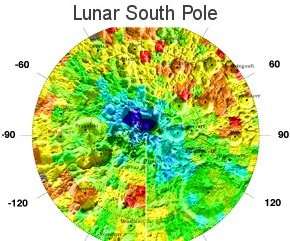Crafty Tricks for Finding Moon Water

Bright gray, crater-pocked mountains taller than Mount McKinley. Abyssal craters that could swallow several Grand Canyons whole.
Recent radar maps of the Moon's southern pole revealed a dramatic, jagged landscape that astronauts could someday call home. But unfortunately, these radar images didn't provide any new information about something that would make living at the lunar pole much easier: frozen water.
New evidence on whether water ice exists at the Moon's poles will have to wait for a robotic probe called Lunar Reconnaissance Orbiter or "LRO." Currently, engineers at NASA's Goddard Space Flight Center are receiving the individual, hand-delivered scientific instruments and integrating them into the satellite, which is scheduled to launch by the end of the year.
The agency's Vision for Space Exploration calls for sending people back to the Moon by 2020 and later establishing a manned lunar outpost. LRO is the first of a series of robotic probes that will gather critical data about the Moon's topography, radiation environment, temperatures, and chemical makeup that NASA scientists need to plan the manned missions.
During LRO's year in orbit around the Moon, the probe will give scientists unprecedented data on whether water ice lies hidden somewhere on the lunar terrain.
Most of the Moon is bone dry. Its surface temperature can exceed 100 °C during the lunar day, which quickly boils any exposed water or ice, and lunar gravity is too weak to keep evaporated water from floating off into space. Frozen water, if it exists, lies only in abyssal craters 2.5 miles deep. Some places in these craters are constantly in shadow year round, so temperatures there plunge to about -400 degrees F (-240 C). That's cold enough to keep water frozen even on the Moon.
Having ice to mine nearby would provide much more than just a ready source of drinking water. Lunar homesteaders could use the water to grow plants for food. Splitting water molecules with electricity from solar panels would produce oxygen to replenish the outpost's air. It would also produce hydrogen gas, an excellent rocket fuel that could power the astronauts' return vehicle. (The fuel for the Space Shuttle's main engines is liquid hydrogen.)
Tantalizing hints from past robotic orbiters suggest that these craters might harbor as much as a cubic kilometer of water ice. The Clementine and Lunar Prospector missions of the 1990s both found indirect evidence of water—or some other hydrogen-bearing compound—in the craters at the Moon's poles. Unfortunately, the data left room for uncertainty.
"It's the job of LRO to pin that down," says Alan Stern, head of the Science Mission Directorate at NASA headquarters in Washington, D.C.
But confirming the existence of ice from an orbit 50 km above the surface will be tricky. Four of LRO's scientific instruments will look for different signs of the presence of ice. If all four instruments point to ice in the same location, that would make a compelling case that ice does exist, says NASA's Richard Vondrak, project scientist for LRO. "I expect that LRO will really answer the question of whether there's water ice at the pole once and for all," Vondrak says.
The easiest way to check if ice exists in those deep craters would be simply to look. But without the diffuse light of a bright blue sky and white clouds, shadows on the Moon are far crisper and darker than shadows here on Earth.
To peer into these inky-black craters, LRO will use a different light source: starlight. One of the instruments aboard LRO can actually "see" the starlight reflected off the lunar surface. That's because this instrument, called Lyman-Alpha Mapping Project (LAMP), detects ultraviolet light. Distant stars are relatively bright in a certain range of UV wavelengths. And as an added bonus, water ice creates a characteristic imprint in the spectrum of the reflected UV light—a spectral "fingerprint" that can help confirm the presence of water.
Also, a laser aboard LRO will briefly illuminate spots on the lunar surface. The purpose of the laser pulses is actually to map the contours of the lunar surface, but the sensor—called Lunar Orbiter Laser Altimeter (LOLA)—will also measure the brightness of the reflected laser light. If the reflections from permanently shadowed craters are slightly brighter than elsewhere, it could mean that ice crystals are present there.
Ice crystals in the lunar soil would have another interesting effect: they would absorb neutrons.
The Moon is awash in high-energy cosmic rays from deep space, and as these particles strike the lunar surface, they create neutrons that stream back out into space. LRO will carry a neutron detector called the Lunar Exploration Neutron Detector (LEND). If LRO flies over a large patch of icy soil hidden in a dark crater, LEND would record a dip in the number of neutrons radiating from below.
And as a final check, LRO will carry a thermometer of sorts called Diviner. This instrument will map the wide variations in temperature at the lunar surface, including the permanently shadowed craters. Even if the other three instruments all suggest that ice is present in a crater, Diviner must also show that it's cold enough there to keep the ice from evaporating away.
If LRO does find ice lurking in those cold, dark craters, it could be the most dramatic feature yet of an already breathtaking moonscape.
Source: by Dr. Tony Phillips, Science@NASA





















